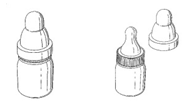Owner of “BIG BABY POP” takes on The Topps Company: Genuine use of 3D mark despite additional elements
This decision re-confirms the rights of 3D trade mark owners, especially when they may have already found it difficult to get trade mark protection in the first place.
Background
In 1999 The Topps Company filed a 3D mark for the sign shown below for various goods (confectionery, sugar confectionery, sweets, candies and sherbet) in class 30:

In 2018 Mr Trebor Robert Bilkiewicz filed an application for revocation of Topps Company’s three-dimensional EU trade mark pursuant to Article 58(1)(a) EUTMR. Topps Company filed evidence that the mark had been used as shown below (also showing the word mark “BIG BABY POP”):

Both the Cancellation Division and later the Second Board of Appeal denied genuine use of the 3D mark, arguing that the mark had merged with the additional figurative and word elements and thus constituted a different sign. Topps Company then further appealed the decision to the General Court and assigned the mark to the new owner (The Bazooka Companies).
General Court decision
The General Court annulled the decision and confirmed genuine use of the mark.
- The court did consider the registered shape and the shape of the baby bottle as used to be identical. They said the existing differences (especially in the proportions) are hardly perceived by the relevant public.
- The court confirmed that a registered trade mark used only as part of a composite mark or in combination with another mark must still be perceived as an indication of the origin of the goods in question.
In that context, the court also emphasised again that the acquisition of distinctive character may result from the use of an element of the registered trade mark as part thereof and from the use of a separate trade mark in conjunction with the registered trade mark. In such cases, it is sufficient that, as a result of that use, the relevant public actually perceives the goods or services identified exclusively by the mark applied for as originating from a particular undertaking. No different standards are to be applied in the parallel context of assessing genuine use. The Court of Justice of the European Union (CJEU) had also confirmed already in the Bullerjan (shape of an oven) case (C-698/17 P) that a three-dimensional mark can be used in conjunction with a word element, without necessarily calling into question the consumer's perception of the shape as an indication of the commercial origin of the goods.
In this particular case, the court found that as well as occupying a significant part of the surface of the product, the word mark “BIG BABY POP!” also alluded to the shape of the baby bottle of which the contested mark was composed (the stylised letter “i" in the shape of a baby bottle and the word “baby” referred to the users of baby bottles). Further, the court states that in the confectionary sector it is very common to find the combination of a 3D shape with additional word or figurative elements. Moreover, from a commercial and regulatory point of view, it would be "inconceivable" to sell the goods in question solely in the shape of the contested mark without any label applied to its surface.
Finally, the court confirmed that the 3D mark did not have to appear on all evidence material such as invoices. In this case, the invoices only showed the word mark “BIG BABY POP!” but the court said this was not unusual and it would be difficult to insert a 3D mark on all business documents.
In short
This decision is welcomed and further strengthens the position of owners of 3D marks by confirming that 3D marks can be genuinely used in combination with word marks, as long as the 3D mark is still perceived by consumers to be an indication of origin.
Case details at a glance
Jurisdiction: European Union
Decision level: General Court
Parties: The Bazooka Companies, EUIPO and Trebor Robert Bilkiewicz
Date: 26 October 2022
Citation: T‑273/21
